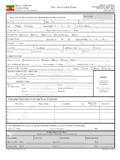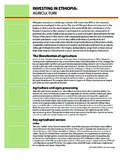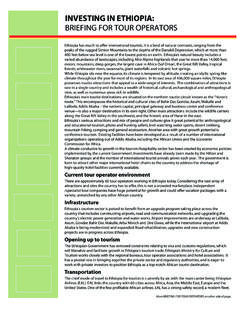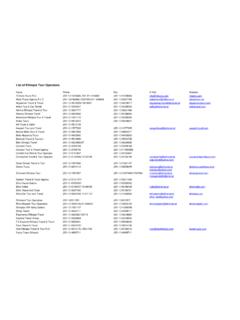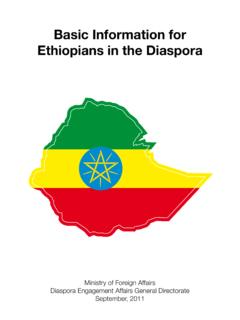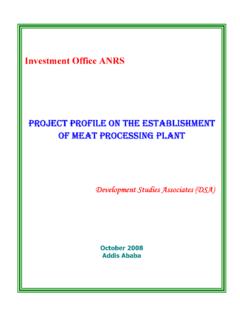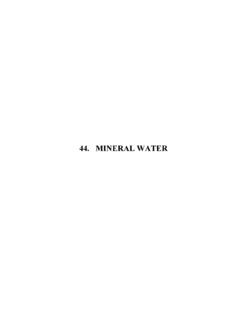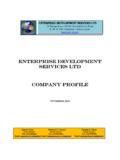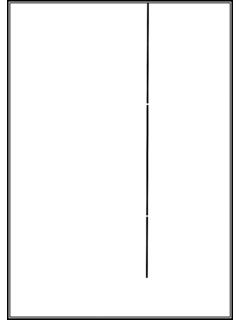Transcription of INVESTING IN ETHIOPIA: FLORICULTURE
1 More FLORICULTURE on other side of page2009200820072006 Expected usable land, in hectaresExpected income, in millions of , $ $58 INVESTING IN ETHIOPIA: FLORICULTUREE thiopia s vast land, favorable climate, and water and land resources combine to make it an incredible hub for investment. Located in the Horn of Africa, ethiopia is at the crossroads between Africa, the Middle East and Europe. Within easy reach of the Horn s major ports, ethiopia is close to its traditional markets for export products the Middle East and Europe. This geographical proximity provides the major exporters in the world unparalleled access to the Ethiopian floricultural productionCurrently in production within ethiopia are a number of flowers, including roses, gypsophilia, hypericum, limonium, carnations and chrysanthemum.
2 The Ethiopian Highlands provide near ideal growing conditions for roses. ethiopia s rose industry grew from 40 hectares productive to 250 hectares productive between 2004 and 2006, and is positioned to grow even of FLORICULTURE investment in EthiopiaFlora Culture International a leading investor in ethiopia has described parts of the country south of Addis Ababa [as being] not unlike the Naivasha area in Kenya, where well over 50% of Kenya's flowers are grown, and could be exploited in much the same way. Many of ethiopia 's farms promote ethically grown produce. Those that do not have the capacity to do so have expressed interest in becoming involved in such initiatives. Dutch Ambasssador to ethiopia Alphons Hennekens has said: The fact that a lot of Dutch companies decided to invest in ethiopia has meant that the investment climate in the country is have seen more spectacular growth in the FLORICULTURE sector here than anywhere else in the world.
3 Last year, the Ethiopian Government introduced a new environmental law on the basis of its work with ethiopia 's Environmental Protection Agency. The procedure involves assessing the environmental impact before a job starts, conducting regular environmental auditing to make sure the environment is not being polluted, and closing down the company if pollution occurs. Investors committed to ethical initiatives and promoting environmentally sustainable flower production can do so in cut flowersThe volume of exports of cut flowers is growing and this is showing great promise as a developing industry sector. A substantial number of investors have started operating in ethiopia due to the Government s focus on this sector and the unparalleled advantages that ethiopia has in floricultural production compared to other producers.
4 Flower exports as a share of total exports grew from in 2001 to in 2005. The value of Ethiopian flower exports rose from $660,000 in 2001 to $12,645,000 in 2005. Agro-climatic conditionsDiverse agro-climatic conditions in the highlands and lowlands of ethiopia make it a suitable place for the production of a wide range of flowering plants, making cut flower production a fast-growing export business. ethiopia has 12 river basins, 18 natural lakes (including the Rift Valley lakes) and a potential of million hectares of irrigable land. About 80-90% of these resources are located in the west and south-west of the country, which is home to 40% of the population. Temperatures are conducive to FLORICULTURE and there are long hours of sunshine - usually more than 11 hours a day.
5 Water for irrigation is available in ample quantity and the well-drained soil in ethiopia is suitable for growing horticultural IN ETHIOPIA: FLORICULTURE2005200420032002200 1 Flower exports, in thousands of dollarsFlower export as share of total export, in percent$660$12, of EthiopiaEconomy and Business Section3506 International Drive , 20008 Tel-202-364-6385 investment codeNew incentives have been offered to investors since ethiopia s investment code was revised in May 2002. The floricultural sector in particular has strong backing from the Government. Incentives such as a five-year tax holiday, duty-free imports of machinery and easy access to bank loans and land have attracted investors. As a result of these and other incentives, ethiopia 's flower business is booming and could potentially overtake coffee as the country s main export commodity.
6 Below are some major incentives granted to investors: A 100% exemption from the payment of import customs duties and other taxes levied on imports is granted to investors to cover the importation of investment capital goods such as plant machinery and equipment. Investment capital goods imported without the payment of import customs duties and other taxes levied on imports may be transferred to another investor enjoying similar privileges. Exemptions from customs duties or other taxes levied on imports are granted for raw materials necessary to produce export goods. Ethiopian products and services destined for export are exempted from paying any export tax and other taxes levied on exports. Any income derived from an approved new manufacturing and agro-industry investment or investment made in agriculture will be exempt from the payment of income tax for different periods of time, depending upon the area of investment selected, the volume of exports and the location in which the investment is undertaken.
7 Any remittance made by a foreign investor from the proceeds of the sale or transfer of shares of assets upon liquidation or winding up of an enterprise is exempted from the payment of any tax. Business enterprises that suffer losses during the tax holiday period can carry forward such losses for half of the income tax exemption period, following the expiration of the exemption environment ethiopia has achieved macro-economic stability. Stable annual economic growth in double digits since 2003. Stable exchange rate. Government commitment to the private sector. Safe and secure working and living environments, identified by the and the International Chamber of Commerce (ICC) as key assets for investors in and unemploymentEthiopia also has globally competitive advantages for quality produce, cost of freight, cost of production and proximity to markets.
8 Labor costs are cheaper than many African countries already involved in FLORICULTURE export. Investments by floricultural companies have created employment opportunities for 16,626 workers (directly) and 66,504 others (indirectly).The labor intensive process required for seeding, cultivating, packing and exporting makes the FLORICULTURE sector unique in absorbing a huge labor associationThe Ethiopian Horticulture Producer Exporters Association (EHPEA) was created to provide a forum for exporters of cut flowers. The trade association currently has 66 member companies, is growing rapidly, and is available to provide advice and membership that could be of benefit to foreign investors looking to import flowers from ethiopia .
9 The country s FLORICULTURE potential is high thanks to diverse agro-ecological conditions for all-year-round production, an abundant, low-cost and easily trained labor force, the proximity to and Middle East markets and strong government support. I don t think there is anywhere else in the world where flowers are produced at a cost of less than 20 dollars per hectare of land per year, according to Ethiopian Minister of Trade and Industry Girman Birru. I don t think there is any country around that has a labor force as disciplined as ours, nor a government so totally in support of promoting and developing the sector on a day-to-day basis".Continued from other side of pag
